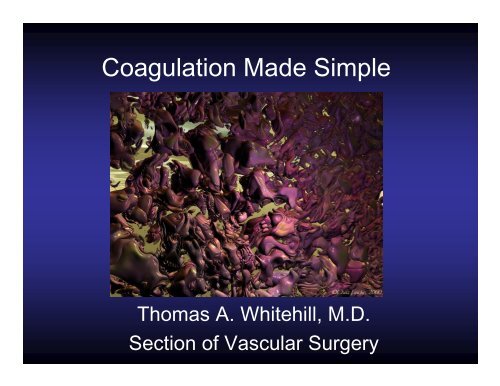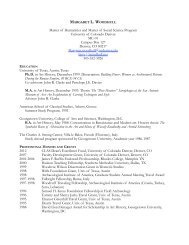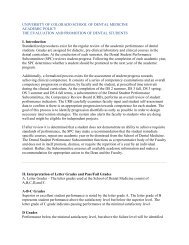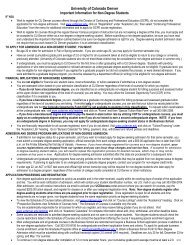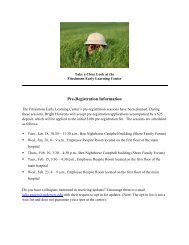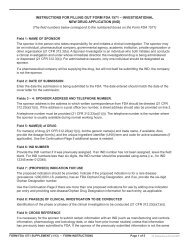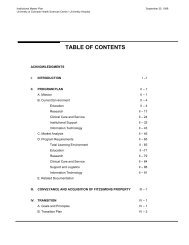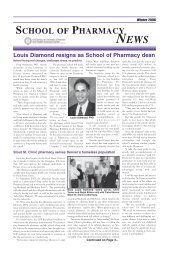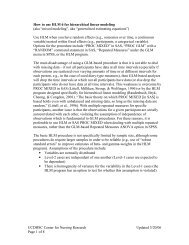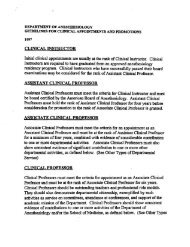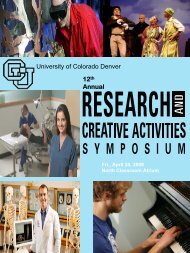Coagulation Made Simple
Coagulation Made Simple
Coagulation Made Simple
Create successful ePaper yourself
Turn your PDF publications into a flip-book with our unique Google optimized e-Paper software.
<strong>Coagulation</strong> <strong>Made</strong> <strong>Simple</strong><br />
Thomas A. Whitehill, M.D.<br />
Section of Vascular Surgery
Objectives of This Presentation<br />
• Identify and describe the critical elements<br />
of the hemostatic mechanisms of the<br />
body<br />
• Develop and implement an effective<br />
diagnostic and therapeutic approach to<br />
the abnormally bleeding patient
Black Box View of Hemostasis<br />
Platelet/coagulation<br />
factor activation<br />
Lots of exciting<br />
biochemistry<br />
CLOT!
Key Points<br />
• Hemostasis requires the interaction of platelets,<br />
coagulation and fibrinolytic factors, endothelium,<br />
proinflammatory and anti-inflammatory mediators,<br />
and leukocytes<br />
• Clot formation is typically initiated by vascular injury, in<br />
which a platelet plug forms and is reinforced with<br />
fibrin produced via the extrinsic pathway<br />
• Physiologic anticoagulants such as AT-III and Activated<br />
Protein C oppose thrombosis, serving to localize it to<br />
sites of vascular injury<br />
• Clot formation is balanced by plasmin-mediated<br />
fibrinolysis, resulting in the formation of D-dimers<br />
and other fibrin degradation products
Vascular Injury<br />
Vasoconstriction<br />
First<br />
Exposure of<br />
Subendothelial Collagen<br />
Platelet Adhesion, Aggregation, and Activation<br />
(Primary Hemostasis)<br />
Second<br />
<strong>Coagulation</strong> Cascade<br />
(Secondary Hemostasis)<br />
Third<br />
Stable Fibrin/Platelet Clot<br />
Fibrinolysis [as needed]<br />
Release of Tissue Factor
Receptor Exposure,<br />
Activation<br />
ADP<br />
PDGF<br />
5-HT<br />
Granule Release<br />
Platelets<br />
Adherence<br />
vWF<br />
GPIb<br />
Activation<br />
Collagen<br />
Thrombin<br />
ADP<br />
Epi<br />
TxA2<br />
Thromboxane A2<br />
Bind Clotting Factors<br />
Fibrinogen<br />
Aggregation<br />
GPIIb<br />
GPIIIa<br />
Vasoconstriction<br />
Platelet Plug (Surface)<br />
PL<br />
Thrombosis
<strong>Coagulation</strong> Factors<br />
• I Fibrinogen<br />
• II Prothrombin<br />
• III Thromboplastin<br />
• IV Calcium<br />
• V Proaccelerin<br />
• VI Same as V<br />
• VII Proconvertin<br />
• VIII Antihemophilic<br />
• IX<br />
• X<br />
• XI<br />
• XII<br />
Christmas<br />
Stuart-Prower<br />
Plasma thromboplastin<br />
antecedent<br />
Hageman<br />
• XIII Fibrin stabilizing
<strong>Coagulation</strong> Factor Fun Facts<br />
Factor<br />
Production<br />
T 1/2<br />
Level for Surgery<br />
Therapy<br />
I<br />
Liver<br />
72-100 hr<br />
> 100 mg/dl<br />
Cryoprecipitate<br />
II<br />
Liver*<br />
50-80 hr<br />
15% - 40%<br />
Plasma<br />
V<br />
Liver, EC<br />
15-36 hr<br />
15 - 25%<br />
Plasma, platelets<br />
VII<br />
Liver*<br />
5 hr<br />
10 - 15%<br />
Plasma, rVIIa<br />
VIII<br />
EC<br />
8-12 hr<br />
100%<br />
Factor concentrate,<br />
DDAVP<br />
IX<br />
Liver*<br />
24 hr<br />
50% - 70%<br />
Factor concentrate<br />
X<br />
Liver*<br />
25-60 hr<br />
10% - 40%<br />
Plasma<br />
XI<br />
Liver<br />
40-80 hr<br />
10% - 25%<br />
Plasma<br />
XII<br />
?<br />
60 hr<br />
--<br />
XIII<br />
Liver<br />
4-7 days<br />
< 10%<br />
Plasma
“Classic” (Test Tube) <strong>Coagulation</strong> Cascade<br />
Contact<br />
XI<br />
XIIa HKa<br />
XIa<br />
Intrinsic Pathway<br />
IX<br />
IXa<br />
TF-VIIa<br />
PL<br />
PL<br />
VIIIa<br />
Extrinsic Pathway<br />
Tissue Factor + VII<br />
X<br />
Prothrombin<br />
Xa<br />
PL<br />
Va<br />
Common Pathway<br />
XIII<br />
Since 1961<br />
Fibrinogen<br />
Thrombin<br />
Fibrin<br />
(weak)<br />
XIIIa<br />
Fibrin<br />
(strong)
“New” (in vivo) <strong>Coagulation</strong> Cascade<br />
Tissue Factor + VII<br />
PL<br />
IX<br />
X<br />
XIa<br />
TF-VIIa<br />
Prothrombin (II)<br />
IXa<br />
PL Ca ++<br />
VIIIa<br />
Xa<br />
PL<br />
Va<br />
XIII<br />
XI<br />
Thrombin (IIa)<br />
Fibrinogen (I)<br />
Fibrin<br />
(weak)<br />
XIIIa<br />
Fibrin<br />
(strong)
Factor VII – Tissue Factor “two-unit enzyme”<br />
• Factor VIIa – catalytic<br />
component<br />
• Tissue factor – regulatory<br />
component (not on EC or<br />
circulating blood cells)<br />
• TF-VIIa (extrinsic Xase)<br />
complex catalyzes X to Xa<br />
• Extrinsic Xase activates IX<br />
• Factor VIIIa + IXa form the<br />
intrinsic factor Xase<br />
– Intrinsic Xase 50x more<br />
effective at catalyzing factor X<br />
activation than extrinsic Xase<br />
VII<br />
TF<br />
PL
The Many Roles of Thrombin<br />
<strong>Coagulation</strong> System<br />
Clot formation:<br />
Fibrinogen Fibrin<br />
F XIII F XIIIa<br />
Amplification/Activiation<br />
F V F Va<br />
F VIII F VIIIa<br />
Platelets<br />
Aggregation<br />
Release reaction<br />
TxA 2 -synthesis<br />
Leukocytes<br />
Chemotaxis<br />
Cytokine<br />
production<br />
Macrophages<br />
Chemotaxis<br />
Antithrombin<br />
Thrombin<br />
Tumor cells<br />
Adhesion<br />
Metastasis<br />
Cell growth<br />
Neurons<br />
Neurite<br />
growth<br />
regulation<br />
Endothelial Cells<br />
Synthesis and release:<br />
Prostacyclin<br />
EDRF, t-PA<br />
Endothelin<br />
Tissue factor<br />
Activation:<br />
Protein C PCa<br />
Thrombomodulin<br />
Fibroblasts<br />
Proliferation<br />
Smooth Muscle<br />
Contraction<br />
Mitogenesis<br />
Heart<br />
Positive inotrope
Physiologic Anticoagulant Mechanisms<br />
Tissue Factor + VII<br />
TFPI<br />
Antithrombin III<br />
PL<br />
IX<br />
X<br />
TF-VIIa<br />
Prothrombin (II)<br />
IXa<br />
PL<br />
VIIIa<br />
Xa<br />
PL<br />
Va<br />
XIII<br />
Proteins C & S<br />
(+ thrombomodulin)<br />
Fibrinogen<br />
Fibrinolysis<br />
Thrombin<br />
Fibrin<br />
(weak)<br />
XIIIa<br />
Fibrin<br />
(strong)
Today’s Rehearsals<br />
• Will my patient bleed?<br />
• Why am I seeing excessive intraoperative<br />
or post-operative bleeding!<br />
• I think my patient has HIT!
Will my patient bleed?<br />
• “Are you a bleeder?” is not enough<br />
– Hx of prolonged or frequent bleeding<br />
• Biting lip or tongue, gums bleed with brushing<br />
• Nosebleeds (excessive and recurrent)<br />
– Bruises without apparent injury<br />
– Prolonged bleeding after dental extraction<br />
– Excessive menstrual bleeding<br />
– Previous operative bleeding<br />
– Relative with a bleeding problem<br />
– Medications (ASA, Plavix, “alternatives”)
Platelet Defect or Factor Deficiency?<br />
• Platelet defect or von Willebrand disease<br />
– Mucocutaneous bleeding<br />
– Excessive bruising, gingival bleeding,<br />
frequent nose bleeds<br />
• <strong>Coagulation</strong> factor defects<br />
– Muscle and joint bleeds<br />
• Both groups will bleed excessively from<br />
injuries and at the time of surgery!
Inherited Defects of Platelet Function<br />
• Platelet function disorders with normal platelet numbers<br />
– Collagen aggregation defects (variable inheritance)<br />
– Glanzmann thrombasthenia (AR)<br />
– Dense body deficiency (AR)<br />
– Secretion defect (varies)<br />
• Thrombocytopenia (large platelets)<br />
– Alport’s syndrome (AD)<br />
– Autosomal dominant thrombocytopenia (AD)<br />
– Bernard-Soulier (AR)<br />
– Gray platelet syndrome (AD)<br />
– May Hegglin anomaly (AD)<br />
– Fechnter syndrome (AD)<br />
– Montreal giant platelet syndrome (AD)<br />
• Thrombocytopenia (normal sized platelets)<br />
– Chédiak-Higashi syndrome (AR)<br />
– Thrombocytopenia with absent radius (TAR, AR)<br />
– Factor V Quebec (AD)<br />
• Thrombocytopenia (small platelets)<br />
– Wiskott-Aldrich syndrome (X-linked)
Acquired or Inherited Factor Disorder?<br />
• Acquired bleeding factor disorders will<br />
often present suddenly with severe<br />
bleeding and newly abnormal<br />
coagulation tests<br />
– Patients have other illnesses but autoimmune<br />
coagulation disorders can suddenly strike any<br />
previously healthy person
Acquired or Inherited Factor Disorder?<br />
• Inherited bleeding factor disorders<br />
– Present from birth until old age<br />
– Mild hemophilia or von Willebrand disease<br />
patients may not have had troublesome<br />
bleeding until the first trauma or surgery<br />
• Do not ignore an abnormal aPTT in an older<br />
patient<br />
• Review family history<br />
– Hemophilia A/B are sex-linked - brothers, cousins, uncles<br />
– Von Willebrand disease may have variable penetrance<br />
within the family
Von Willebrand Disease (vWD)<br />
• The most common inherited bleeding disorder<br />
– 1% of the population<br />
– Five forms or types are known and distinguishable<br />
– Classic – reduced VIII activity and decreased vWF<br />
• vWF is crucial for the interaction of platelets with<br />
damaged vasculature<br />
• vWF is also the carrier protein for factor VIII<br />
(otherwise, free VIII is labile in the plasma)<br />
• vWD usually results from either a drop in vWF<br />
concentration or impaired vWF/VIII function
Von Willebrand Disease (vWD)<br />
• Patients with vWD have “platelet-type”<br />
bleeding (nosebleeds and bruising)<br />
– Joint bleeding is rare<br />
– Bleeding as a child, less as an adult<br />
– Testing (a challenge)<br />
• Bleeding time (variable sensitivity)<br />
• Factor VIII level<br />
• Von Willebrand antigen<br />
• Ristocetin cofactor activity (binds vWF to platelets)<br />
• Crossed immunoelectrophoresis<br />
• Therapy: DDAVP, Humate-P, cryoprecipitate
Will my patient bleed?<br />
• Level I concern<br />
– History is negative<br />
– Procedure planned is relatively minor<br />
No screening tests are recommended
Will my patient bleed?<br />
• Level II concern<br />
– History is negative<br />
– Screening tests have been negative in the<br />
past<br />
– Major operation is planned (procedure not<br />
usually attended with significant bleeding)<br />
Platelet count, peripheral smear, PT-INR,<br />
aPTT
Will my patient bleed?<br />
• Level III concern<br />
– History is suggestive of poor hemostasis<br />
– Procedure may impair hemostasis (CPB or<br />
cell saver) or the procedure may leave behind<br />
a large, raw surface<br />
– Minimal post-operative bleeding will be<br />
injurious (craniotomy)<br />
Platelet count, PT-INR, aPTT,<br />
+/- bleeding time (PFA-100)
Will my patient bleed?<br />
• Level IV concern<br />
– History highly suggestive of a hemostatic<br />
defect<br />
– Hematology consult<br />
Platelet count, bleeding time, PT-INR, aPTT,<br />
euglobulin clot lysis analysis, factor assays<br />
Bleeding time test + ASA provocative test<br />
If emergent – platelet aggregation testing<br />
and thrombin time (TEG, if available)
Will my patient bleed?<br />
• Patients with liver disease, renal failure,<br />
obstructive jaundice, possibility of<br />
disseminated malignant disease<br />
Platelet count, aPTT, PT-INR (uremic<br />
patients usually have a vitamin-K<br />
deficiency)<br />
• Patients with uremia (qualitative platelet<br />
function abnormality)<br />
Bleeding time (improved with dialysis or<br />
administration of DDAVP)
Laboratory Monitoring of <strong>Coagulation</strong><br />
• Prothrombin Time (PT-INR)<br />
– Plasma + Calcium + Tissue Thromboplastin<br />
TF + VIIa → Xa + V → IIa → CLOT<br />
• PT-INR only elevated<br />
– Factor VII deficiency<br />
• Congenital (very rare)<br />
• Acquired (Vit K deficiency, liver disease)<br />
– Factor VII inhibitor<br />
– Rarely in pts with modest decreases of factor V or X
Laboratory Monitoring of <strong>Coagulation</strong><br />
• Activated Partial Thromboplastin Time (aPTT)<br />
– Plasma + Calcium + Kaolin + Phospholipids<br />
Contact → XIa → IXa + VIII →Xa + Va →IIa →CLOT<br />
• PTT only elevated<br />
• Factor XI, IX, or VIII deficiency<br />
• Factor XI, IX, or VIII specific factor inhibitor<br />
• Heparin contamination<br />
• Antiphospholipid antibodies
Laboratory Monitoring of <strong>Coagulation</strong><br />
• Both PT-INR and aPTT are elevated<br />
– Factor(s) X, V, or II deficiency<br />
– Factor(s) X, V, or II inhibitor<br />
– Improper anticoagulation ratio (Hct >60 or ↑ PT-INR)<br />
– Large Warfarin effect ((↑ PT-INR > ↑ aPTT)<br />
– Low fibrinogen (
Laboratory Monitoring of <strong>Coagulation</strong><br />
• Four causes of elevated aPTT and response to 50:50 mix<br />
o Factor XI, IX, or VIII deficiency<br />
o Corrects with 50:50 mix (normal pool plasma)<br />
o Factor XI, IX, or VIII specific factor inhibitor<br />
o May correct at time zero but then prolongs<br />
o Heparin contamination<br />
o Does not correct at all with normal pool plasma<br />
o Antiphospholipid antibodies<br />
o Does not fully correct at time zero or any time point
Laboratory Monitoring of <strong>Coagulation</strong><br />
• Thrombin Clotting Time (TCT)<br />
– Add thrombin to patient’s plasma<br />
• This should directly clot fibrinogen<br />
– Elevated in<br />
• Heparin use<br />
• DIC<br />
• Dysfibrinogenemia<br />
• Low fibrinogen levels<br />
• High fibrinogen levels<br />
• Uremia
Intraoperative Bleeding<br />
“Surgical”<br />
Discrete bleeding points<br />
Obvious source<br />
Typical scenario<br />
Find it: Look at potential sites<br />
“Coagulopathic”<br />
Diffuse oozing<br />
Late in case? Early in case? Pre-existing<br />
problem?<br />
(Get help, if needed)<br />
Venous<br />
Arterial<br />
Sudden?<br />
Progressive?<br />
Suspect congenital<br />
or pre-existing<br />
problem<br />
Treat as indicated<br />
Hematology assistance?<br />
Pack<br />
Get more help!<br />
Direct suture<br />
Ligate<br />
Pack and close<br />
Proximal and<br />
Distal control<br />
Transfusion reaction<br />
Medications<br />
Hypothermia<br />
Acidosis<br />
DIC<br />
Dilution<br />
Primary fibrinolysis
HEROIC AWARD TIME!!<br />
Save of the Month Club<br />
• Kaptain Koagulation<br />
– Brian Peyton<br />
• Kid Clotter<br />
– Jayer Chung<br />
• Infected aortic graft<br />
– Ax-bifem graft<br />
– Laparotomy<br />
– Pseudoaneurysm<br />
resection and aortic<br />
closure<br />
• Extreme bleeding!!<br />
• Extreme<br />
coagulopathy!!<br />
• Couldn’t remove<br />
aortic X-clamp!!!
Evaluation of Excessive Intraoperative<br />
or Postoperative Bleeding<br />
• Ineffective or incomplete local hemostasis<br />
• Complications of blood transfusion<br />
– Massive blood transfusion<br />
– Hemolytic transfusion reaction<br />
• Previously undetected hemostatic defect<br />
• Consumptive coagulopathy<br />
• Fibrinolysis
Evaluation of Excessive Intraoperative<br />
or Postoperative Bleeding<br />
• Ineffective or incomplete local hemostasis<br />
√ Enough factor XV (Ethicon)?<br />
√ CBC, platelet count<br />
√ Bedside PT, aPTT<br />
√ Blood transfusion record<br />
√ Review patient’s history again (quickly)
Evaluation of Excessive Intraoperative<br />
or Postoperative Bleeding<br />
• Complications of blood transfusion<br />
– Massive blood transfusion<br />
• Usually, patients who receive 10 units or more of<br />
banked blood within 24 hrs will be<br />
measurably thrombocytopenic, this is<br />
commonly not associated with a hemostatic<br />
defect<br />
• If there is diffuse bleeding, an 8- to 10-pack of<br />
fresh platelet concentrate should be given<br />
empirically (no clear association between the<br />
platelet count, bleeding time, and profuse<br />
bleeding)
Evaluation of Excessive Intraoperative<br />
or Postoperative Bleeding<br />
• Complications of blood transfusion<br />
– Hemolytic transfusion reaction<br />
• First hint – diffuse bleeding in an operative field<br />
that had previously been dry<br />
• Pathogenesis –<br />
– release of ADP from hemolyzed rbcs, resulting in diffuse<br />
platelet aggregation, after which the platelet clumps are<br />
swept out of the circulation (relative thrombocytopenia)<br />
– Release of procoagulants – intravascular defibrination<br />
– Triggering of the fibrinolytic mechanism
Evaluation of Excessive Intraoperative<br />
or Postoperative Bleeding<br />
• Previously undetected hemostatic defect<br />
– Congenital defects<br />
• Factor deficiencies<br />
– VIII (Hemophilia A, and/or von Willebrand’s disease)<br />
– IX (Hemophilia B or Christmas disease)<br />
– XI (Hemophilia C)<br />
– II, V, and X<br />
– VII<br />
– XIII<br />
– Transfusion purpura<br />
• Antibodies to donor platelets, which eventually destroy the<br />
host’s own platelets
Evaluation of Excessive Intraoperative<br />
or Postoperative Bleeding<br />
• Consumptive coagulopathy (DIC) vs Fibrinolysis<br />
– No single test can confirm or exclude the<br />
diagnosis or distinguish between the two<br />
• Thrombocytopenia, positive plasma protamine test<br />
for fibrin monomers, a low fibrinogen level<br />
(
Life saver? rFVIIa<br />
• Recombinant (activated) Factor VII<br />
– Initiates hemostasis at sites of bleeding<br />
• Directly activates thrombin on platelets<br />
– Used in various complex settings<br />
• Hemophilia, inhibitors to factors VIII or IX<br />
• Warfarin-associated bleeding<br />
• Massive transfusion coagulopathy<br />
• Acute intracerebral hemorrhage<br />
• Cardiac Surgery<br />
• Severe trauma
FVIIa<br />
• Anticoagulant reversal agent?<br />
– Hemorrhage due to LMWH – anecdotal<br />
– Potential reversal agent for most of the newer<br />
anticoagulant agents?<br />
• Reports of efficacy are derived from lab<br />
experiments or from healthy volunteers<br />
– Reversal of warfarin<br />
– Reversal of hirudin<br />
– Reversal of fondaparinux<br />
• Recommendations will require clinical data
Half of your patient’s platelets disappeared<br />
overnight! Where did they go?<br />
• HIT = heparin-induced thrombocytopenia<br />
– Occurs in 0.6 to 30%* of patients who have<br />
received heparin<br />
• HITTS = heparin-induced thrombocytopenia<br />
and thrombosis syndrome<br />
– Occurs in 3% with thrombosis in 0.9%<br />
– Morbidity and mortality reported at 61% and<br />
23 %, respectively<br />
*25-50% of post-cardiac surgery pts Ab (+) during the next 5-10 days!
Heparin- Induced<br />
Thrombocytopenia<br />
• HIT begins 3 to 14 days after heparin<br />
exposure<br />
– Bovine, porcine, lmw heparins all guilty<br />
• Suspect the diagnosis if…<br />
– 50% drop in platelet count [on heparin]<br />
– Fall in platelets below 100,000 [on heparin]<br />
– Thrombosis while on heparin<br />
– ? Sepsis or DIC
Heparin- Induced<br />
Thrombocytopenia<br />
• Treatment<br />
– Stop all heparin products<br />
– Allow the heparin effect to<br />
wear off [ongoing<br />
prothrombotic state –<br />
micro-particles]<br />
– Warfarin contraindicated<br />
until adequate alternative<br />
anticoagulation established<br />
• Prothrombotic state similar to that<br />
of warfarin-induced protein<br />
C/S deficiency<br />
• May lead to venous gangrene or<br />
worse
Anticoagulants Approved for Use by the FDA<br />
Generic Name<br />
Trade Name<br />
Mechanism<br />
Indications<br />
Application<br />
Warfarin<br />
Coumadin/Generic<br />
Vitamin K<br />
Art/Ven thrombosis<br />
Oral<br />
Anisindione<br />
Miradon<br />
Vitamin K<br />
Art/Ven thrombosis<br />
Oral<br />
Unfractionated<br />
Heparin<br />
Various agents<br />
Thrombin/factor Xa<br />
antagonist<br />
Art/Ven thrombosis<br />
IV, SC<br />
Fractionated<br />
Heparins<br />
Fragmin<br />
Lovenox<br />
Factor Xa/thrombin<br />
inhibitor<br />
VTE prophylaxis &<br />
treatment, ACS<br />
IV, SC<br />
Antithrombin<br />
Thrombate III<br />
Thrombin/factor Xa<br />
antagonist<br />
AT III deficiency<br />
IV<br />
Danaparoid<br />
Orgaran<br />
Factor Xa/thrombin<br />
inhibitor<br />
VTE prophylaxis<br />
IV<br />
Argatroban<br />
Argatroban<br />
Thrombin inhibitor<br />
HIT<br />
IV<br />
Lepirudin<br />
Refludin<br />
Thrombin inhibitor<br />
HIT<br />
IV<br />
Bivalirudin<br />
Angiomax<br />
Thrombin inhibitor<br />
PCI<br />
IV<br />
Fondaparinux<br />
Arixtra<br />
Factor Xa inhibitor<br />
VTE prophylaxis in<br />
Orthopedics<br />
SC<br />
Drotecogin alfa<br />
Xigris<br />
Factor Va/VIIIa<br />
inhibitor<br />
Severe sepsis<br />
IV
What if Surgery “Requires” Heparin?<br />
• Consider status of HIT<br />
– Active HIT:<br />
• Avoid surgery<br />
• Avoid heparin<br />
– Subacute HIT<br />
• Avoid surgery<br />
• Consider alternatives<br />
to heparin<br />
• Heparin if absolutely<br />
necessary<br />
– History of HIT<br />
• Consider alternatives to<br />
heparin<br />
• Heparin, monitor closely
Black Box View of Hemostasis<br />
Platelet/coagulation factor activation<br />
Lots of exciting biochemistry<br />
that I now really understand!<br />
CLOT!


